Transportation timeframes play an essential role in both the production and service industries. This is why logistics companies always try to find the optimal set of routes for their vehicles to make fast delivery. Given the complexity of the multi-criteria Vehicle Routing Problems (VRP), detailed computation must be handled quickly.
The powers of the Central Processing Unit (CPU) and Graphics Processing Unit (GPU) offer the most effective solutions to the problem-solving process. The first one manages all the main functions of a computer, while the second one serves as a specialized element to run many small tasks simultaneously.
Recently, GPUs have gained a crucial role in transportation, as well as logistics and supply chain management. So in this article, we discuss how to solve multi-criteria VRPs on GPU.
Understanding the Multi-Criteria Vehicle Routing Problems
Such problems are associated with the control policies required to coordinate several vehicles moving in a metric space. They usually depend on several factors, including the task generation process, the vehicle dynamics and constraints, the data available to the vehicles, and the performance objective.
Ensuring the system’s stability, the number of outstanding tasks remains a serious concern. Traditional objectives rely on service quality measures, namely the best and the worst time before the task completion. In this context, the scalability of the control policies across several vehicles often leads to the distributed computation of the available information.
This is where the use of GPUs is required to enhance a system's speed and processing capabilities.
Dive into the role of AI in optimizing transportation and logistics
Benefits of GPU for Solving a Vehicle Routing Problem
GPUs serve as the hardware device used for running applications that compute technical and scientific data in an accelerated way. When it comes to GPU-based VRP solutions, at least several benefits can be highlighted:
- Boosting the speed and processing capabilities of a system;
- Performing computing applications to add efficiency;
- Compatible with a variety of software and applications
Solving your VRP manually is incredibly complicated so professional assistance may be required. The logistics software development experts can solve your delivery service’s vehicle routing problem quickly and at a reasonable cost. But here are the main options you are looking at.
GPU Programming Languages and Platforms
GPU Programming is a way of managing highly parallel computations on GPU accelerators. It uses several languages and platforms depending on the project's needs.
OpenCL and VRP
OpenCL operates as a low-level API for heterogeneous computing that runs on CUDA-powered GPUs. Bringing an open standard that executes calculations simultaneously on different devices enables developers to start computing kernels using a limited subset of the programming language on a GPU.
CUDA and VRP
CUDA is an accessible platform that provides direct access to the GPU’s virtual guidance and parallel computational compounds. These are required for the formation of compute kernels. It is eligible for work with C, C++, and Fortran. CUDA doesn't require any skills in graphics programming, being accessible to software developers through special libraries and compiler directives. This makes CUDA and VRP compatible with each other.
CUDA’s hardware optimization is 30% faster than its closest alternative. OpenCL provides a wide range of debugging and profiling tools, making detecting bugs and optimizing code easier. It is rarely used for machine learning, though, so its small community has a few libraries and tutorials on that.
Algorithm Design for GPU-based VRPs
Designing parallel algorithms means executing several instructions simultaneously on different processing devices and then combining the available outputs to generate the final result. It is important to follow the principles while creating dynamic VRPs on GPU:
- Identify the pieces of work to be performed concurrently;
- Map out work across independent processors;
- Distribute a program's input, output, and intermediate data;
- Manage shared data while trying to avoid conflicts;
- Maintain proper order of work through synchronization
The Pareto-based approach consists of two interrelated dimensions: dominance and diversity estimators. Both of them are optimized in a way that one dimension cannot improve without a second one declining. This makes it valid for solving optimization problems with two and three objectives. This approach is used if the desired results and performance indicators produce a compromise.
Case Study: Effective Navigation Solution for UK-based Drivers

The scalarization technique relies on performance indicators that build a scalar function integrated with the fitness operations. It provides multi-objective functions wrapped up into a single solution using equal, rank-order centroid, and rank-sum weights. Each of them directly works on the representation of GPU kernels.
In terms of GPU-based VRPs, it takes a few steps to create the proper algorithm. Which include:
- Generate an initial solution. Pick the most reasonable algorithm to solve your vehicle routing problem faster without compromising optimality or accuracy.
- Develop a neighborhood search strategy. The intro route heuristic method is useful in complex search systems. It works to decrease the number of vehicles in the VRP, which is the main goal of using an intro route heuristics search in this problem.
Some transformations are possible while progressing in the VRP algorithm implementation. These changes include 2OPT, SWAP, and RELOCATE based on the legit guarantee where a local search involves the optimal routes. This involves short-term routes with up to 20 visits. To develop optimal tours, inter-route operators are asked to decrease the complete distance along with the number of vehicles.
- Optimize the route. Determine the optimal route for traveling based on input aspects such as best value or shortest arrival time. A route optimization algorithm explores available travel paths and automatically produces navigation instructions. Integrating a GPS vehicle tracking system can significantly enhance this process by providing real-time updates and accurate location information.
Advanced Topics in Multi-Criteria VRP on GPU
CPU and GPU clusters are the most progressive branches in parallel computing and data processing. They increase the throughput of data and the number of concurrent calculations within an application. GPU cannot substitute a CPU. A GPU supports CPU architecture by enabling repetitive calculations within an application to be processed in parallel while the major program keeps running on the CPU.
The CPU can be viewed as the task maker of the entire system, controlling a wide range of general-purpose computing tasks. This is where the GPU performs a small range of specialized tasks. Using the power of parallelism, a GPU can manage more work within the same timeframes compared to a CPU.
Dealing with Dynamic VRPs on GPU
Regarding hybrid CPU-GPU solutions for VRP, the unique computing hardware technology introduces a genetic algorithm (GA)-based approach working on graphics processing units (GPUs). Being a hybrid algorithm, it aims to detect the best route with the shortest distance for the capacitated vehicle routing problem.
By providing array compounds over the GPU grid and using GPU kernel operations, the suggested algorithm reveals high-quality solutions at a high-level computational speed and near-optimal solutions for limited benchmark issues. Within the dynamic framework, the execution speed issue in the VRP can be addressed through an algorithm that relies on GPU.
Transform challenges into opportunities with our expertise
On top of that, heuristic methods can make up high-quality solutions within acceptable computational timeframes. Many heuristic mechanisms progressively develop solutions for the VRP.
Genetic algorithms, for instance, utilize some basic reproduction features, including selection, mating, and mutation processes. This is how they rely on some potential solutions, which enhance the probability of finding the best solutions and using them in various VRP scenarios.
Future Trends and Challenges in VRP on GPU
The current reputation of graphics processors is associated with continuous advancements and improvements of the latest models by companies such as NVidia, AMD, and Intel. The latest GPUs demonstrate better performance, improved energy efficiency, and high support for new technologies. These include AI-based rendering and real-time ray tracing.
The future of VRP on GPU views the possibility of utilizing the highest possible capacity of the GPU for a VRP as a hard thing to achieve. First, it is necessary to select an algorithm. Through various manipulations, it needs to be adjusted to the GPU architecture. For example, enhancing the instance by decreasing the number of vehicles used can be possible. A new solution has already been approved by Sintef and can become a common thing.
Special action needs to be taken in the area of data saving. It can be possible to use the linked arrays, which order the data used for the vehicle routing problem properly. By the end of the day, the main stall reason is still associated with memory dependencies.
The vehicle routing problem relies on data operations rather than computations. Improving the data transactions will surely benefit the algorithm. One possible way to achieve the desired result is to reorder customers during the algorithm. This will cause additional instructions and decrease the memory dependency of the algorithm.
Conclusion
Whenever you take the case study: VRP on GPU, you will need an effective algorithm and its GPU implementation. This algorithm will handle the parallelism of the GPU in an initial solution and improve it by selecting the best vehicles with the minimum resources required.
However, there can be some variations depending on each particular scenario. The right parallel algorithm gives feasible solutions with the best cost and at a very interesting time.
While VRP on GPU is a complex routine that takes time and effort, handling it on your own is not always possible. Contact us and get assistance from specialists competent in the latest tech to develop high-performing solutions for businesses of any scope.

Our team is dedicated to delivering high-quality services and achieving results that exceed clients' expectations. Let’s discuss how we can help your business succeed.


SHARE: